Update: Councilors Tuesday agreed to study the dredging issue in an upcoming meeting of the Public Works Committee.
The dam for the Lower Longview Lake is getting some repairs, but city staff and lakeside residents disagree on how that should be done.
City staff intend to repair the 70-year-old dam and spillway, but residents want something done about the lake, which they say has lost some of its depth due to decades of sediment buildup.
The city will shell out the $2.5 million needed to repair the dam, spillway and the public street that runs over it. Albemarle Avenue over the dam has been closed since 2009, when the city deemed it unsafe.
The History
Located in East Raleigh just off of New Bern Avenue, Lower Longview Lake was constructed in the mid 1940s. The Longview Gardens subdivision grew around the lake and about 20 properties were given deeded interests to the lake.
As with all private lakes, a homeowners association was created to maintain it.
The Longview Gardens Association was formed and is listed on the deed, but the organization isn’t currently active and hasn’t been for at least 30 years.
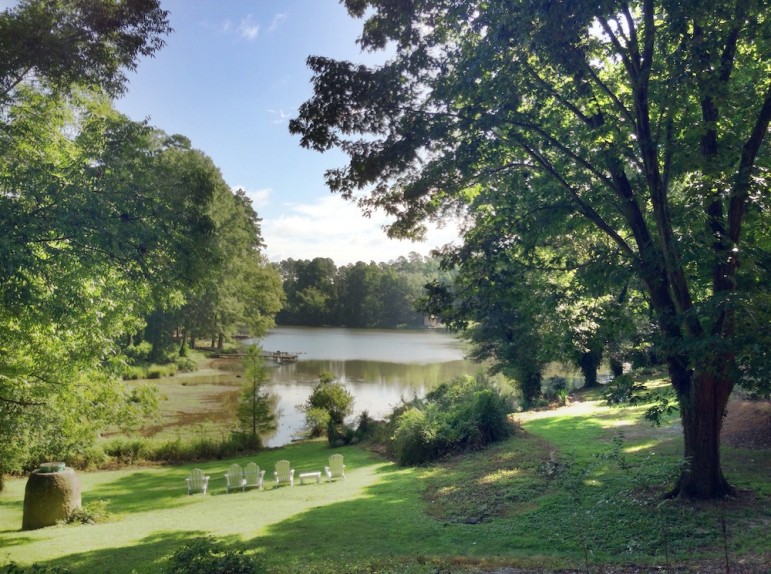
Without a formal organization to maintain the lake, decades worth of sediment buildup has occurred and the dam and spillway fell into disrepair.
While the dam hasn’t failed, Raleigh senior project engineer Scott Bryant said that water has overtopped during tropical storms and hurricanes, most notably during Hurricane Fran in 1996. The state considers it a high-hazard dam, which means there is a potential for loss of life and property downstream if it were to breach.
“It needs to be upgraded from a dam safety perspective,” Bryant said.
The road on top of the dam was closed in 2009, when a city-hired consultant found that it wasn’t structurally sound.
Years of sediment deposit has created a wetland where water flows from the Upper Longview Lake into the lower lake. The upper lake is already undergoing remediation, including sediment removal.
Without anyone regularly cleaning out the sediment in the lower lake, trees and other vegetation began to grow. Although wetlands are considered a good thing from a water quality standpoint, the lake has lost much of its depth and its capacity.
Bryant said the wetlands “would be considered by the regulatory authorities as a regulatory wetland,” which would require additional permits if anything were to be changed.
At this point, the wetlands haven’t been deemed as such.
The city is following the recommendations from a 2002 study that outlined priority stormwater and dam projects. The study was a result of the city’s Lake Preservation Policy, which was established in 1994. Both the upper and the lower lakes were included in that study and were put into the city’s Lake Preservation Program, but sediment removal was only recommended for the upper lake.
A ranking system for those stormwater and dam projects was put into place around 2005.
Project engineer Chris Stanley said the upper and lower Longview Lakes are ranked No. 2 out of 102 facilities.
While the lower lake was put into the preservation program in the early 2000s, the dam and the spillway project were added a few years later. Stanley said that discussions about the condition of both date back to the 1980s.
The design was already underway when a 2009 field study determined that Albemarle Avenue over the dam wasn’t structurally sound. The road has been closed ever since.
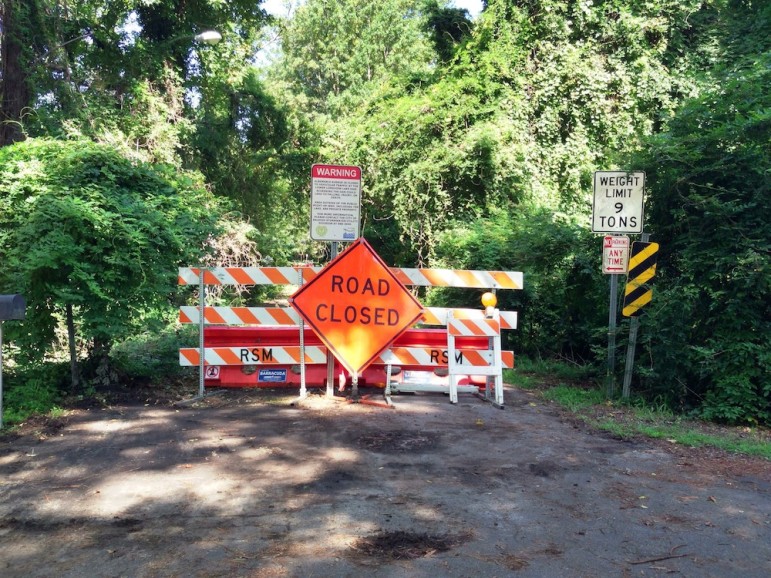
James Borden / Raleigh Public Record
The closed portion of Abermarle Avenue.
“The dam and spillway have also been on the state’s Dam Safety Office and City of Raleigh stormwater’s priority lists for some time for replacement,” Stanley wrote in a followup email to the Record.
Funding for both projects was approved in 2009.
Bryant said that the study was done prior to the city establishing a stormwater utility department and funding for these projects wasn’t available until fees began being collected.
Now, Stanley said construction plans have been approved by the state and the city is working on acquiring the easements necessary to finally do the work.
The lake will be drained and a new spillway will be installed in the middle of the lake. The dam and street will be rebuilt to today’s standards. When completed, the street will be wide enough to install a sidewalk in the future.
The intent, said Stanley, is to make it so water can pass through the dam properly and won’t overtop during major rain events, like hurricanes or tropical storms.
Restoring the Lake
Lakeside residents are generally in favor of rebuilding the dam, but many would like to see the lake restored as well.
“This is what they’re basing everything on,” said resident Gloria Putnam, as she held up thick, bound copy of the stormwater and dam study. “A lot has changed since 2002.”
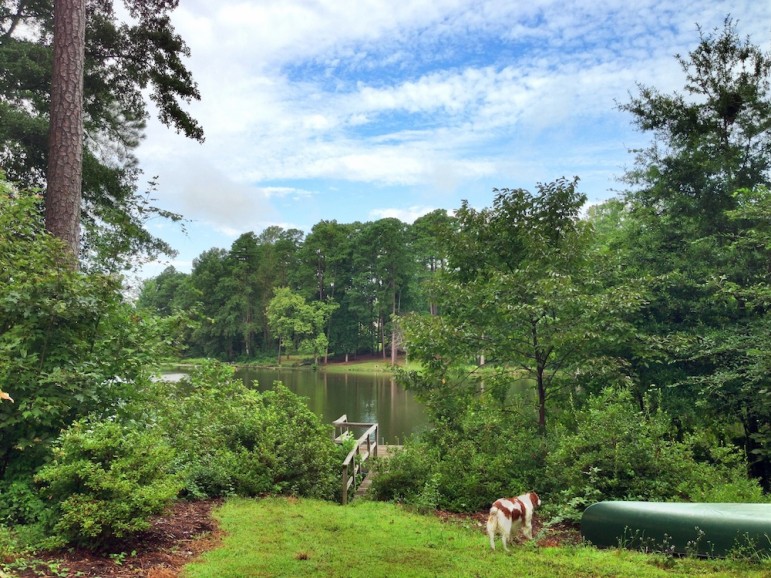
James Borden / Raleigh Public Record
Putnam's backyard with her dog and the lake in the background.
Putnam has lived on the lake since 2004, and she and her husband Michael are two of about 20 residents who own deeded interest to the lake.
Her well-kept backyard could double as a nature preserve; it is a haven for an array of animals that live near the lake and in its wetlands. In the nine years that she’s lived there, she’s witnessed the wetlands grow and the depth of the lake shrink.
While she doesn’t think the study is bad, “We think things have changed a lot since 2002 and they shouldn’t hang their hat on this.”
Putnam, who works for N.C. State as a coastal resources and communities specialist, wants the city to consider excavating the lake while it is drained to add back some of its depth.
Because the wetlands haven’t been officially identified by the state, she wrote in an email that she doesn’t have a strong opinion as to whether they should go or stay.
Bryant, however, sees maintaining the wetlands as a bigger benefit than restoring the lake. The city often builds wetlands as a way to manage stormwater and improve water quality. In this case, nature did the work.
“We’re doing this very thing by design,” Bryant said.
Bryant said he agrees there is some benefit to increasing the lake’s capacity because it would be able to hold more water during major storms. From a water quality standpoint, however, Bryant said that leaving the wetlands is much more effective.
At community meeting in late August, many residents were concerned about the depth of the lake and expressed a desire for city staff to consider excavating it.
Stanley told residents that staff would continue to follow the original plans, unless the City Council directed them to do otherwise. He told the Record that a new study probably wouldn’t yield different recommendations.
Who’s Responsible
The majority of Raleigh’s lakes are privately owned and maintained, but because those lakes and streams play a role in water quality, Bryant said the city has a vested interest in making sure dams and spillways associated with those lakes are functioning.
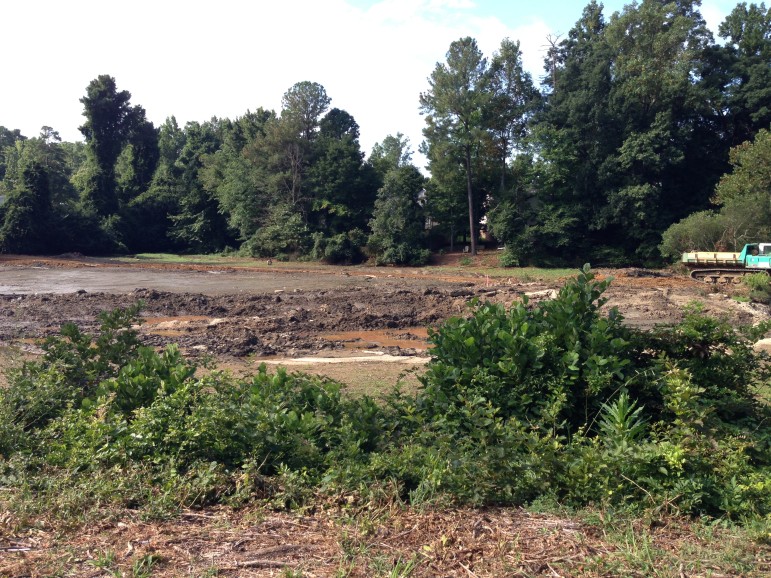
James Borden / Raleigh Public Record
A stream restoration project along Longview Lake Drive.
The city will use public funds from stormwater utility fees to repair dams and spillways, but afterward, the ongoing maintenance often becomes the responsibility of the homeowners.
Putnam said that the residents want to continue to privately own the lake, but isn’t sure how the funds will be raised to maintain it or if a new association will be created.
At the August meeting, residents questioned the responsibility of future dam upkeep. Because the dam has a public road running across it, some residents believe that the city should also maintain the dam.
“Once reopened to public traffic, the city normally would be responsible for keeping the road in good repair. If maintaining the dam across which the road travels is essential to that duty, there is an argument that the city might be responsible for the dam as well,” said Professor Michael Kent, associate law professor at Campbell University, in an email to the Record.
A similar case, Kent wrote, took place in Kernersville, N.C. The town agreed to repair and maintain a dam after the Department of Environment and Natural Resources found deficiencies in it.
Despite agreements with multiple parties, the town failed to do the required work.
“Property owners along the lake sued the municipality, which defended its failure on the basis that repairing the dam would create a private lake for the use and enjoyment of the adjacent landowners,” wrote Kent, who has experience in environmental, real estate and land use law.
By using public funds, the town took the position that it would create a private benefit, which would be in violation of the public purpose doctrine, he said.
“The North Carolina Court of Appeals rejected that argument, in part, because a public road ran across the dam and the municipality admitted that it had a duty to keep the road safe for public travel. Because repair of the dam would facilitate safety along the road, the repair of the dam served a valid public purpose,” he wrote.
Kent explained that the tricky part of this case is that the town neglected to do the work it agreed to do. Because the work was never done, it is unknown who would have been responsible for the future maintenance.
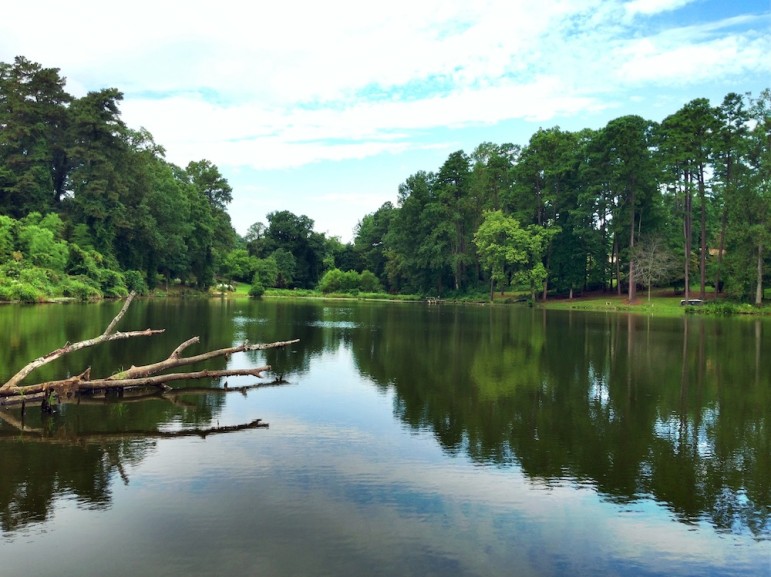
In the case of Lower Longview Lake, the city will be responsible for maintaining the dam and the spillway, but Stanley wrote that the property owners would continue to be responsible for the lake.
Brentwood Today Lake
In a similar case, Brentwood Today Lake residents have been waiting for the city to take over the responsibility of the lake since the mid-1990s.
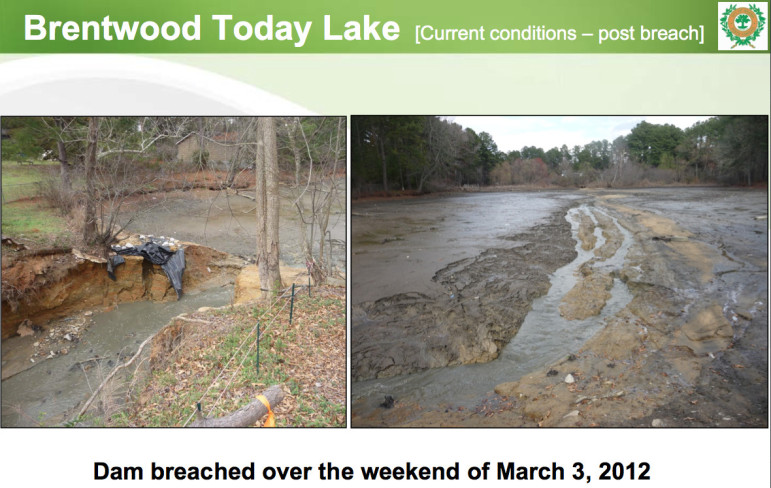
The dam breached in March 2012 and the lake emptied, leaving the city with two options. It could restore the lake and require the residents to keep up with the maintenance, or it could turn the stream into wetlands.
The lake itself is owned by a private company, which wants to donate the lake to the residents, the city or another organization.
During a July 2012 Public Works Committee meeting, Councilman Thomas Crowder said he does not want the city to take on the liability that goes with the lake. He would agree to it, he said, if the city could build a trail around the lake and turn it into a public amenity.
The suggestion didn’t go over well with residents.
The lake remains the responsibility of the property owners, and City Councilors have asked that they come up with a way to ensure long-term maintenance.
Next Steps for Lower Longview
City staff is now in the process of getting permanent easements from nearby property owners. The permanent easement will allow the city to do work in the future without having to ask for permission again.
Stanley said he hopes the city will be able to go out for bid for a company to do the work with construction starting next spring.
Residents, on the other hand, are still meeting with city officials about the old report and future maintenance responsibility.
“We plan to petition the City Council to look at this issue again considering the age of the 2002 report and its ‘old’ data,” wrote Putnam in a follow up email, “as well as the new conditions/opportunities that exist, and work with us to find a new way forward.”
